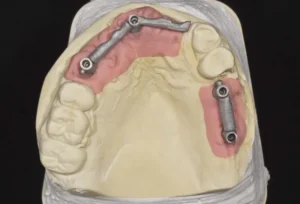A fixed dental bridge is a longstanding solution for replacing missing teeth, effectively bridging the gap and restoring both function and aesthetics to your smile. This type of dental prosthesis is anchored on either side by natural teeth or implants, offering a stable and durable option. They not only improve the ability to chew and speak, but also prevent remaining teeth from shifting, which could lead to further oral health issues. Understanding the different types of fixed dental bridges can help you and your dentist decide the best option tailored to your specific needs.
Types of Fixed Dental Bridges
Fixed dental bridges are a popular solution for replacing missing teeth. They are designed to be stable and enduring, without requiring removal for cleaning. This makes them a convenient and reliable option for many patients. In this section, we will explore the different types of fixed dental bridges available, focusing on their unique characteristics and advantages.
Understanding the different types of fixed dental bridges can help you make an informed decision about which option might be best suited for your dental needs. Here are the primary types of fixed dental bridges:
Traditional Fixed Dental Bridge
The traditional fixed dental bridge is one of the most common types used in dental practice. It comprises one or more artificial teeth held in place by dental crowns cemented onto the adjacent teeth. This type of bridge is particularly effective in areas where there are healthy teeth on either side of the gap created by the missing teeth.
Benefits of Traditional Fixed Dental Bridges:
- Provides strong and durable support by relying on adjacent teeth for stability.
- Offers excellent aesthetics by blending seamlessly with natural teeth.
- Relatively straightforward procedure with a high success rate.
However, it is important to note that traditional fixed dental bridges require the alteration of the adjacent teeth to fit the crowns, which involves removing some of the tooth structure. Therefore, patients need to have sufficiently strong and healthy supporting teeth.
Cantilever Fixed Dental Bridge
A cantilever fixed dental bridge is a less common option used when there is only one adjacent tooth available to support the bridge. This type of bridge involves anchoring the artificial tooth to only one side, making it suitable for areas where adjacent teeth are not available on both sides of the gap.
Advantages of Cantilever Fixed Dental Bridges:
- Useful in specific situations where traditional bridges are not applicable.
- Requires less alteration of the adjacent tooth compared to traditional bridges.
- Can be a suitable option in areas with limited space.
However, the downside is that cantilever bridges can place additional stress on the supporting tooth, potentially leading to complications such as tooth damage or loosening over time. Therefore, careful consideration and planning are required before opting for this type of bridge.
Maryland Bonded Bridge
The Maryland bonded bridge, also known as a resin-bonded bridge, is a more conservative option that does not require extensive preparation of the adjacent teeth. This type of bridge involves a metal or porcelain framework with “wings” that are bonded to the back of the adjacent teeth using a strong dental adhesive.
Benefits of Maryland Bonded Bridges:
- Minimally invasive procedure with minimal alteration to the adjacent teeth.
- Quick and simple placement with immediate load-bearing capability.
- Effective in restoring aesthetics and function in the anterior region where less bite pressure is exerted.
While Maryland bonded bridges are less durable compared to traditional bridges due to the adhesive used, they offer a viable solution for patients looking for a conservative and aesthetically pleasing option. They are particularly useful for replacing single missing teeth in the front of the mouth.
To learn more about dental bridge options and other restorative dental procedures, be sure to explore our other articles. We offer a wealth of information to help you make the best decisions for your dental health.
Advantages of Fixed Dental Bridges
Fixed dental bridges offer multiple benefits for patients who have lost one or more teeth. These bridges can significantly enhance the quality of life by providing improved functionality and aesthetics. The following are some of the key advantages of opting for fixed dental bridges.
Incorporating advanced implantology techniques and bone regeneration strategies, fixed dental bridges can create a stable and long-lasting solution. Here are some of the main advantages:
- Restoring full functionality
- Enhancing aesthetic appearance
- Improving oral health
Restoring Functionality
One of the primary advantages of fixed dental bridges is their ability to restore the functionality of the mouth. Missing teeth can make it difficult to chew food properly, affecting nutrition and overall health. Fixed dental bridges help by providing a stable surface for chewing and grinding food, thus improving digestion and nutrient absorption.
Moreover, they can help in maintaining the alignment of your remaining teeth. When a tooth is missing, adjacent teeth may shift into the empty space, causing bite misalignment and other dental issues. Fixed dental bridges prevent such movement, thereby maintaining proper bite and jaw alignment.
In edentulous sections, implants are commonly placed as distal as possible and another as mesial as possible to achieve excellent biomechanics of the bridge. This strategic placement ensures that the load is evenly distributed, providing stability and longevity to the dental bridge.
Aesthetic Improvements
Besides functionality, fixed dental bridges also offer significant aesthetic benefits. Missing teeth can impact the appearance of your smile and even cause a sunken facial structure over time. Fixed dental bridges can replace these missing teeth, restoring not just your smile but also the natural shape of your face. The materials used for fixed dental bridges are designed to mimic the appearance of natural teeth closely. This means that your smile will look natural and appealing, boosting your confidence in social and professional settings. High-quality materials such as porcelain or ceramic are often used, and they are highly durable and stain-resistant, ensuring that your smile remains bright and beautiful for years. Furthermore, placing the implants in a “tripod” shape can significantly enhance the biomechanics of the restoration. This advanced technique allows for excellent load transmission to the bone, making the dental bridge not only functional but also aesthetically pleasing.
By understanding the numerous advantages of fixed dental bridges, you can make an informed decision about your dental health. For more insights and detailed articles on advanced dental treatments, feel free to explore our blog further.
Procedure for Getting a Fixed Dental Bridge
Obtaining a fixed dental bridge involves several critical steps that ensure the stability, functionality, and longevity of the dental restoration. The process typically begins with a comprehensive evaluation and planning phase. During this phase, detailed diagnostic images, such as X-rays and CT scans, are taken to assess the bone structure and identify the optimal placement for the implants. This step is crucial as placing the implants in the most distal and mesial positions possible allows for optimal biomechanics of the bridge.
Once the evaluation is complete, the next phase involves the placement of the dental implants. These implants act as the foundation for the bridge and must be strategically placed to ensure the best load distribution and support. In cases where the posterior areas of the upper jaw are involved, special care must be taken to avoid sinus elevations. Similarly, in the posterior areas of the mandible, it’s essential to avoid the dental canal. The implants should ideally be placed in a “tripod” formation to enhance the biomechanics of the restoration, allowing for excellent load transmission to the bone.
After the implants are placed and have had time to osseointegrate, the final step is attaching the fixed dental bridge. This bridge is typically splinted onto at least two or three implants to provide added stability and distribute the load more evenly. This approach ensures that the bridge can withstand the daily forces exerted during chewing and other activities, providing a durable and long-lasting solution for patients with missing teeth. Given the complexity and precision required at each stage, it’s essential to follow these steps meticulously to achieve the best possible outcome for the patient.
Cost of Fixed Dental Bridges
The cost of fixed dental bridges can vary significantly based on several factors. It is essential to understand these variables to make an informed decision about dental health investments. Generally, the expense can range anywhere from $1,500 to $15,000, contingent upon various determinants.
One of the primary considerations is the material used in the bridge. Porcelain-fused-to-metal (PFM), all-ceramic, and all-metal bridges all come with different price tags. Additionally, the complexity of the dental issue and the number of teeth involved also play a crucial role in determining the overall cost.
Factors Affecting Cost
Several factors directly impact the cost of fixed dental bridges:
- Type of Material: As mentioned above, the choice between PFM, all-ceramic, and all-metal can significantly affect the price.
- Number of Units: The more units or teeth involved in the bridge, the higher the cost.
- Location: Dental fees can vary based on geographical region. Urban areas may have higher costs compared to rural settings.
- Complexity of the Case: More complicated dental issues that require additional procedures such as bone grafting or sinus elevations will increase the overall expense.
A detailed consultation with your dental specialist will provide a clearer estimate tailored to your specific needs, taking into account both medical and logistical factors.
Insurance Coverage
Understanding the extent of insurance coverage for fixed dental bridges is crucial for financial planning. Most dental insurance plans cover a portion of the cost, but the coverage can vary widely. It is vital to review your insurance policy to understand what percentage of the procedure is covered, the annual maximum payout, and whether pre-existing conditions or other limitations might apply.
Additionally, some insurance plans may cover specific materials over others. For example, they might favor porcelain-fused-to-metal bridges over all-ceramic ones, thus impacting your out-of-pocket expenses. Always consult with your insurance provider and dental specialist to ensure you have a comprehensive understanding of your coverage.
In conclusion, the cost of fixed dental bridges is influenced by multiple factors, including material choice, the number of units, geographic location, and the complexity of the dental issue. Insurance coverage can help mitigate some of these costs, so understanding your policy is essential. For more detailed information on dental care options, consider reading our other articles, which delve into advanced dental procedures and their benefits.
Key Considerations for Optimal Fixed Dental Bridge Placement
When considering a fixed dental bridge, especially in complex areas like the posterior regions of the upper jaw or the mandible, certain strategic placements and considerations are crucial for both patient comfort and optimal functionality of the bridge. Here’s a common question answered in light of these concerns.
How are implants positioned to support a fixed dental bridge in challenging dental scenarios?
In situations involving the back areas of the mouth, particularly the upper jaw and mandible, avoiding procedures like sinus elevations or steering clear of the dental canal are significant considerations. For effective results, in edentulous sections, placing one implant as distally as possible and another as mesially as possible is recommended to ensure good biomechanics of the bridge. Additionally, adopting a tripod-like configuration for the placement of the implants can substantially enhance the biomechanics of the restoration, offering excellent load transmission to the bone. This strategic implant placement not only supports the fixed dental bridge effectively but also preserves essential anatomical structures.

My name is Salman Kapa, a 73-year-old expert in bone regeneration and dental implantology. With decades of experience in the field, I am dedicated to advancing our understanding of oral health and hygiene. Through my research and writing, I aim to contribute to the development of innovative solutions in dental care.




